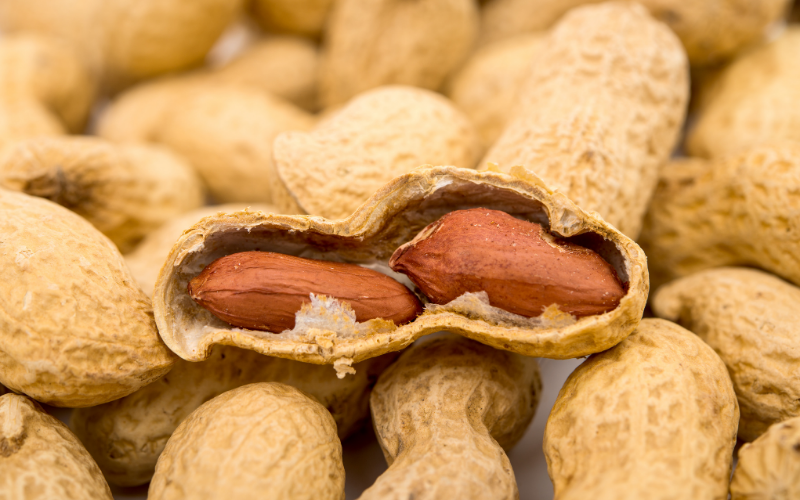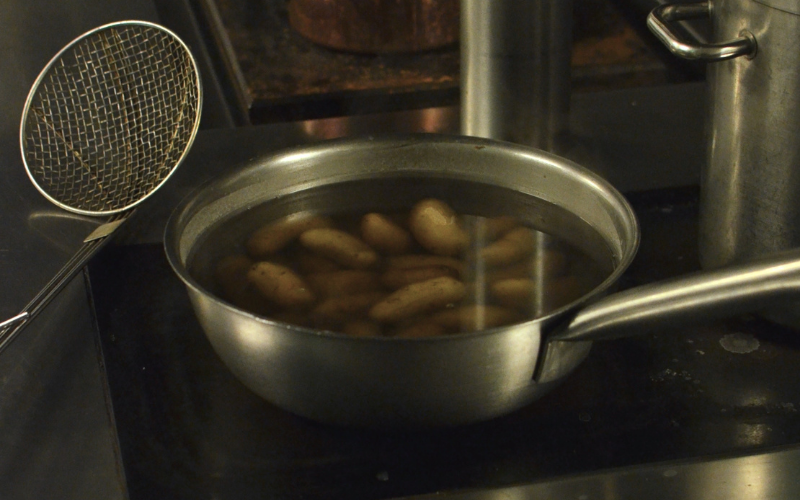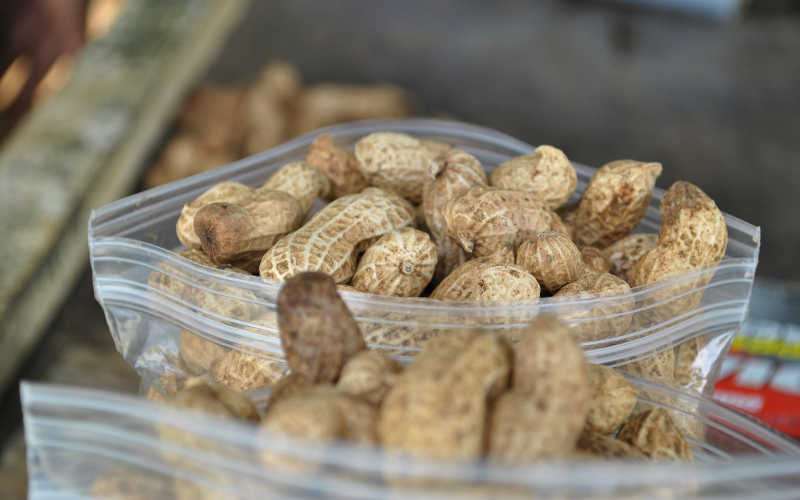Peanuts are a popular and versatile snack enjoyed by people all over the world. When you crack open a peanut, you’re left with the question: Can you eat peanut shells? In this comprehensive article, we will delve into the topic and provide you with all the information you need to know about peanut shells. From their composition and potential health benefits to the risks associated with consuming them, we’ve got you covered. So, let’s get started!
What Are Peanut Shells?

Peanut shells, also known as peanut hulls, are the hard outer covering that protects the edible part of the peanut. These shells serve as a natural barrier, shielding the delicate peanut from external factors like moisture, pests, and diseases. While peanut shells are not typically consumed as part of the snack, they have been gaining attention recently due to their potential nutritional value and culinary uses.
What Are Peanut Shells Made Of?
Peanut shells are primarily composed of cellulose, lignin, and some hemicellulose. Cellulose is a complex carbohydrate found in the cell walls of plants, while lignin provides structural support. These components make peanut shells tough and resistant to decomposition. Additionally, peanut shells contain trace amounts of minerals and antioxidants, which may offer certain health benefits.
Can You Eat Peanut Shells?
Yes, you can eat the peanut shells, but it’s not a common practice for most people. Peanut shells are often discarded due to their tough and fibrous nature. However, if you enjoy the taste and texture of peanut shells, you can consume them after proper preparation and cooking.
Technically speaking, peanut shells are edible, but they are not commonly consumed as a regular part of the diet. Peanut shells are quite fibrous and can be tough and difficult to digest. Most people prefer to remove the shells before eating peanuts for a more enjoyable snacking experience. However, in some cultures, roasted or boiled peanuts with shells intact are a popular treat, and the shells are eaten along with the nuts.
How to Eat Peanut Shells?

If you decide to consume peanut shells, it’s essential to prepare them properly to ensure they are safe to eat and more palatable. Here’s a simple method to enjoy peanut shells:
- Start by selecting fresh, high-quality peanuts in their shells.
- Rinse the shells thoroughly under running water to remove any dirt or debris.
- Preheat your oven to 350°F (175°C).
- Spread the rinsed peanut shells evenly on a baking sheet.
- Bake the shells for about 10-15 minutes until they become slightly crispy.
- Allow the shells to cool before consuming.
- Crack open the shells and enjoy the peanuts inside, along with the crunchy texture of the shells.
Health Benefits of Peanut Shells
While peanut shells may not be a common dietary choice, they do offer some potential health benefits due to their nutritional content. Here are a few possible advantages of consuming peanut shells:
- Fiber: Peanut shells are a good source of dietary fiber. Fiber aids in digestion, helps maintain bowel regularity, and may contribute to heart health.
- Antioxidants: Peanut shells contain antioxidants, such as resveratrol and phenolic compounds, which help neutralize harmful free radicals in the body.
- Minerals: Peanut shells provide small amounts of essential minerals like magnesium, potassium, and phosphorus, which play vital roles in various bodily functions.
The Health Risks of Eating Peanut Shells
While there are potential benefits associated with peanut shells, it’s important to be aware of the health risks as well. Here are a few considerations:
- Digestive Issues: Peanut shells are high in fiber and can be difficult to digest for some individuals, leading to bloating, gas, or discomfort.
- Contamination: If peanuts were sprayed with pesticides, the shells may contain residues that can be harmful if consumed. It’s crucial to opt for organic or pesticide-free peanuts whenever possible.
- Allergic Reactions: Peanut allergies are common and can cause severe reactions. Even if you’re not allergic to peanuts themselves, the shells could still trigger a reaction due to cross-contamination.
How to Prepare and Cook Peanut Shells?
If you’re interested in experimenting with peanut shells in your culinary endeavors, here’s how you can prepare and cook them:
- Wash and Dry: Thoroughly wash the peanut shells to remove any dirt or contaminants. Afterward, allow them to dry completely.
- Roasting: Preheat your oven to 350°F (175°C). Spread the washed and dried shells on a baking sheet and roast them for about 10-15 minutes until they turn slightly brown and crispy.
- Seasoning: Once the shells are roasted, you can season them with various spices or flavors to enhance their taste. Consider options like salt, paprika, garlic powder, or chili powder.
- Enjoy: Allow the seasoned peanut shells to cool before consuming. They can be enjoyed as a crunchy snack or used as a topping for salads, soups, or stir-fries.
Some Tips for Preparing and Safely Consuming Peanut Shells
When it comes to consuming peanut shells, it’s crucial to follow proper preparation and safety guidelines. Here are some tips to keep in mind:
- Quality Matters: Always choose fresh, good-quality peanuts with intact shells for the best taste and safety.
- Thorough Cleaning: Rinse the peanut shells under running water and remove any visible dirt or debris.
- Avoid Contaminated Peanuts: Opt for organic or pesticide-free peanuts to minimize the risk of consuming harmful residues.
- Moderation is Key: While peanut shells may offer certain benefits, moderation is key. Incorporate them into your diet as an occasional treat rather than a regular staple.
- Allergy Alert: If you or anyone in your household has a peanut allergy, it’s essential to avoid peanut shells altogether to prevent potential allergic reactions.
Different Ways You Can Enjoy Eating Peanut Shells
If you’re feeling adventurous and want to explore different ways to incorporate peanut shells into your meals or snacks, here are a few ideas:
- Peanut Shell Trail Mix: Combine roasted peanut shells with other nuts, dried fruits, and seeds to create a flavorful and crunchy trail mix.
- Crunchy Salad Topping: Crushed roasted peanut shells can add texture and a nutty flavor when sprinkled over salads.
- Peanut Shell Crumble: Crush roasted peanut shells and sprinkle them over ice cream or desserts for an interesting twist.
- Peanut Shell Brittle: Create a unique brittle by coating roasted peanut shells with caramelized sugar. Allow it to cool and harden before breaking into bite-sized pieces.
- Peanut Shell Crusted Chicken: Crushed and mixed with breadcrumbs, roasted peanut shells can be used as a coating for chicken or other proteins.
Recipes That Incorporate Peanut Shells as an Ingredient
For those who love to experiment with flavors and textures, here are a couple of recipes that incorporate peanut shells as an ingredient:
Crunchy Peanut Shell Coleslaw
Ingredients:
2 cups shredded cabbage
- 1 cup grated carrots
- ½ cup mayonnaise
- 2 tablespoons apple cider vinegar
- 1 tablespoon honey
- ½ cup crushed roasted peanut shells
Instructions:
- In a large mixing bowl, combine shredded cabbage and grated carrots.
- In a separate bowl, whisk together mayonnaise, apple cider vinegar, and honey to make the dressing.
- Pour the dressing over the cabbage and carrot mixture and toss well to coat.
- Just before serving, sprinkle the crushed roasted peanut shells on top for added crunch.
Peanut Shell Crusted Fish Fillets
Ingredients:
- 4 fish fillets (tilapia, cod, or any white fish)
- ½ cup all-purpose flour
- 2 eggs, beaten
- 1 cup crushed roasted peanut shells
- Salt and pepper to taste
- Cooking oil for frying
Instructions:
- Preheat your oven to 375°F (190°C).
- Season the fish fillets with salt and pepper.
- Dredge each fillet in flour, dip it in beaten eggs, and then coat it with crushed peanut shells.
- Heat cooking oil in a skillet over medium heat. Fry the coated fish fillets until golden brown on both sides.
- Transfer the fillets to a baking sheet and bake in the preheated oven for an additional 10-15 minutes until cooked through.
- Serve the fish fillets with your choice of sides.
The Vietnamese sauce that uses peanuts as a main ingredient is called Vietnamese Peanut Sauce. It is a delicious and versatile sauce commonly used in Vietnamese cuisine. It typically includes ingredients such as roasted peanuts, hoisin sauce, garlic, soy sauce, lime juice, and sometimes chili peppers or Sriracha for a spicy kick. Vietnamese Peanut Sauce is often used as a dipping sauce for spring rolls, grilled meats, or as a dressing for salads. It adds a rich and nutty flavor to dishes and is loved for its creamy texture and savory taste.
Is It OK to Eat Fried Peanut Shells?
Fried peanut shells can be enjoyed as a crunchy snack. When fried, the shells become more brittle and easier to chew. However, it’s important to consume fried peanut shells in moderation as part of a balanced diet, as excessive intake may lead to digestive discomfort.
Can You Eat Boiled Peanuts Shell and All?
In certain culinary traditions, boiled peanuts with shells intact are a popular snack. The shells soften during the boiling process, making them easier to chew and digest. If you’re a fan of boiled peanuts, you can consume the shells along with the nuts. However, remember to wash the shells thoroughly before boiling to ensure cleanliness.
What Can I Do with Peanut Shells?
If you’re not keen on consuming peanut shells directly, there are several alternative uses for them:
- Compost: Peanut shells are biodegradable and can be added to a compost pile to enrich the soil.
- Mulch: Crushed peanut shells can be used as mulch in your garden to retain moisture and suppress weed growth.
- Animal Bedding: Peanut shells can be repurposed as bedding material for small animals like hamsters or birds.
- Fire Starter: Dry peanut shells make excellent kindling for starting fires in fireplaces or grills.
Can Peanut Shells Make You Sick?
While peanut shells are generally safe to consume, they may cause digestive discomfort or allergic reactions in some individuals. Additionally, if the peanuts were treated with pesticides, the shells may carry residues that can be harmful. To minimize the risk of adverse effects, it’s best to consume peanut shells in moderation and opt for organic or pesticide-free peanuts whenever possible.
How Do You Clean Peanut Shells?
Cleaning peanut shells is a straightforward process. Here’s how you can do it:
- Rinse: Place the peanut shells in a colander or strainer and rinse them thoroughly under running water. Rub the shells gently to remove any dirt or debris.
- Soak: Fill a bowl or sink with water and add a small amount of mild dish soap. Place the rinsed peanut shells in the soapy water and let them soak for a few minutes.
- Scrub: Use a clean brush or sponge to scrub the shells, paying attention to any stubborn dirt or stains.
- Rinse Again: After scrubbing, rinse the peanut shells once more under running water to remove any soapy residue.
- Dry: Spread the cleaned shells on a clean towel or paper towels and allow them to air dry completely before use.
Are Roasted Peanut Shells Good for Anything?
Roasted peanut shells can be repurposed in various ways. Here are a few ideas:
- Garden Fertilizer: Crushed roasted peanut shells can be added to garden soil to improve its texture and provide nutrients as they break down.
- Craft Projects: Peanut shells can be used in crafts and DIY projects, such as creating decorative pieces or as components in mosaics.
- Animal Feed: Peanut shells can serve as a treat or supplement for certain animals, such as chickens or birds.
How Long Does It Take for Peanut Shells to Break Down?

Peanut shells are composed of sturdy materials like cellulose and lignin, making them slow to break down. Under optimal conditions, it can take several months to a year for peanut shells to fully decompose. The rate of decomposition can be influenced by factors like moisture, temperature, and the presence of microorganisms in the compost pile or soil.
Do Peanuts in Shell Have Pesticides?
Peanuts in their shells can potentially contain pesticides if they were treated during cultivation. Pesticides are used to protect crops from pests and diseases. To reduce the risk of consuming pesticides, opt for organic or pesticide-free peanuts, or wash the shells thoroughly before consumption.
What Is the Black Stuff on Peanut Shells?
The black stuff often found on peanut shells is a type of mold called Aspergillus. It is a common occurrence on peanuts, especially if they were not stored properly or exposed to moisture. While some molds can be harmless, certain types of Aspergillus can produce toxins that are harmful if consumed in large quantities. Therefore, it’s advisable to avoid peanuts with excessive mold growth or discoloration.
Peanut Shell Nutrition
Although peanut shells are not typically consumed in large quantities, they do offer some nutritional value. Here’s a breakdown of the nutritional content in 100 grams of peanut shells:
- Calories: 398 kcal
- Protein: 18.2 grams
- Fat: 20.6 grams
- Carbohydrates: 42.9 grams
- Fiber: 23.4 grams
- Calcium: 64 mg
- Iron: 2.3 mg
- Magnesium: 251 mg
- Potassium: 1,123 mg
- Zinc: 2.1 mg
Intestinal Blockage Concerns
One of the primary concerns related to consuming peanut shells is the potential for intestinal blockage, especially if large quantities are consumed. The fibrous nature of the shells can be difficult for the digestive system to break down completely, leading to discomfort or blockage. It’s important to exercise caution and consume peanut shells in moderation to prevent any gastrointestinal issues.
Beware of Pesticide Contamination
As mentioned earlier, peanuts and their shells can contain pesticide residues if they were treated during cultivation. Pesticides are chemicals used to protect crops from pests and diseases. To minimize exposure to pesticides, opt for organic or pesticide-free peanuts whenever possible. Washing the shells thoroughly can also help remove any surface residues.
Eating Disorder Considerations
Individuals with eating disorders or a history of disordered eating should approach consuming peanut shells with caution. The fibrous and bulky nature of the shells may trigger discomfort or distress in individuals with restrictive eating patterns or gastrointestinal sensitivities. It’s important to prioritize one’s mental and physical well-being and seek guidance from a healthcare professional if needed.
FAQs
Are peanut shells toxic?
Peanut shells are not toxic, but they can be tough and difficult to digest. It’s advisable to consume them in moderation and ensure they are properly prepared and cooked.
Can peanut shells cause allergies?
Peanut shells can potentially cause allergic reactions in individuals with peanut allergies or cross-reactive allergies. It’s important to exercise caution and avoid peanut shells if you have known allergies.
Are peanut shells high in fiber?
Yes, peanut shells are high in fiber. They can contribute to your daily fiber intake, promoting digestive health and helping maintain bowel regularity.
Can I feed peanut shells to animals?
Peanut shells can be fed to certain animals, such as chickens or birds, as a treat or supplemental feed. However, ensure that the shells are clean and free from contaminants.
Can peanut shells be composted?
Yes, peanut shells are biodegradable and can be added to a compost pile. They contribute to organic matter and help enrich the soil.
Can roasted peanut shells be reused?
Roasted peanut shells can be repurposed as garden mulch or used in craft projects. They can also serve as a fire starter due to their flammable nature.
Conclusion
In conclusion, while peanut shells are technically edible, they are not commonly consumed as part of the regular diet. Peanut shells can be tough and difficult to digest, leading most people to remove them before eating peanuts. However, if you enjoy the taste and texture of peanut shells, they can be prepared and cooked to enhance their palatability. Additionally, peanut shells offer some potential health benefits, such as being a source of fiber and containing minerals and antioxidants. However, it’s crucial to consider the health risks associated with consuming peanut shells, including potential digestive issues and pesticide contamination. As with any dietary choice, moderation is key. So, the next time you crack open a peanut, consider the option of enjoying the shells alongside the nuts for a unique snacking experience.